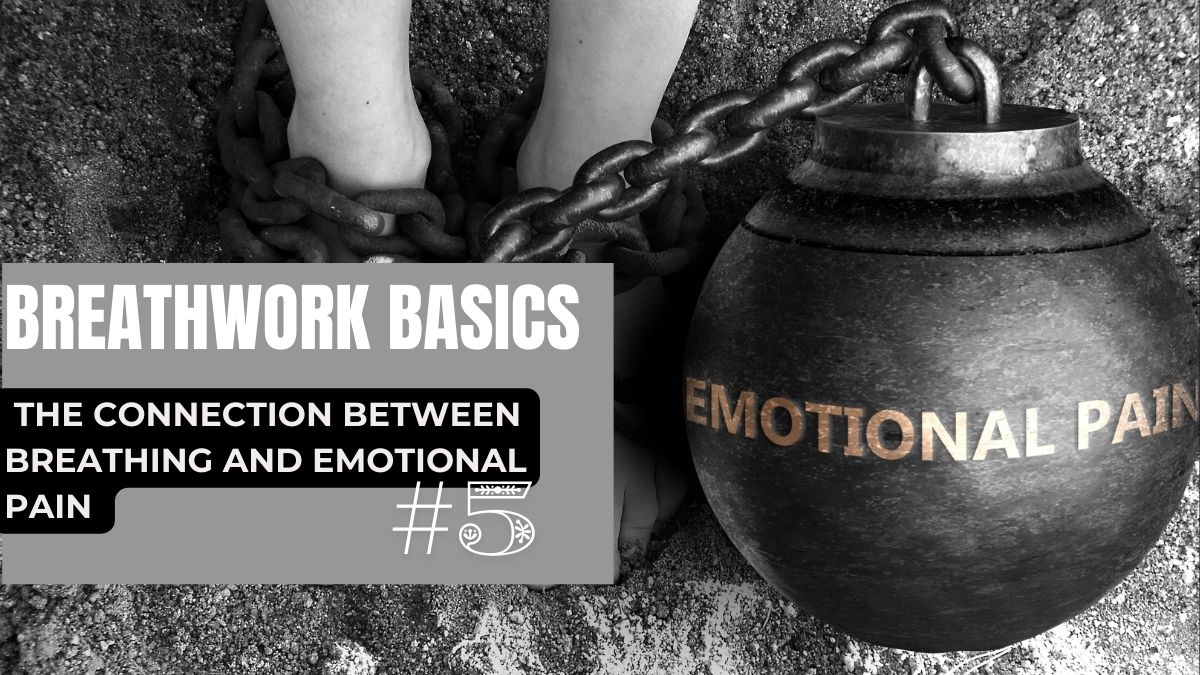Breathwork Basics 5: Understanding The Connection Between Breathing And Emotional Pain

This blog dives into how different breathing patterns impact our emotional state and the complex connection between our emotions and pain.
Hi there! Today, we're going to explore the powerful connection between breathing and emotional pain. Breathing is more than just a physical act; it's deeply linked to how we feel emotionally. When we face emotional pain such as sadness, anxiety, or stress, our breathing patterns often change, which can make these feelings even worse.
Breathing Patterns and Emotional Pain
Shallow Breathing
When we're upset, we might take quick, shallow breaths. This reduces the amount of oxygen our body receives and can make us feel even more anxious. Shallow breathing often comes with feelings of nervousness or stress, creating a cycle where anxiety causes shallow breathing, which in turn increases anxiety.
Irregular Breathing
When our emotions are all over the place, our breathing can get messed up. This uneven breathing can make us feel unsteady and more sensitive. It's common to have irregular breathing when we're going through emotional ups and downs, and it can add to the feeling of being out of control.
Panic Attack
In extreme cases of panic or anxiety, we might breathe too quickly. This is called hyperventilation, and it can cause dizziness, tingling, and a feeling of doom. Hyperventilation can make panic worse, creating a scary cycle.

Chronic Pain
Chronic pain is different from acute pain, like stubbing your toe. Imagine if you stubbed your toe every day. Over time, the pain would become chronic and likely have a significant emotional impact.
Chronic pain often has a substantial emotional component:
- Emotional Distress: Ongoing pain can lead to feelings of hopelessness, frustration, and depression. It might stop us from doing things we love, like walking or meeting friends.
- Pain Catastrophising: This is when we focus on and exaggerate pain, often feeling helpless and constantly thinking about the pain.
The Emotional Signature of Pain
Pain Perception
The experience of pain involves two main parts:
- Sensory-Discriminative Aspect: This is the physical feeling of pain, like how strong it is and where it hurts.
- Affective-Motivational Aspect: This is the emotional response to pain, like feeling scared, upset, or angry.
Emotional Amplification
Emotions can make pain feel worse. For example:
- Anxiety and Fear: These can make us feel pain more strongly.
- Depression: This can make us less able to handle pain, making it feel worse.
- Stress: This can make long-term pain problems, like fibromyalgia or headaches, feel more intense.
Examples of Emotional Pain
Car Accident Scenario
Imagine being in a car accident where people get hurt. The emotional responses can vary greatly between individuals involved:
- Driver's Perspective: If the driver feels responsible, they might experience guilt, shame, or self-blame, which can intensify their physical pain.
- Passenger's Perspective: Passengers might feel anger or resentment towards the driver or others involved, adding an emotional layer to their physical injuries.
Complex Emotional Responses
These different emotional reactions show how complicated pain can be. Guilt and self-blame can cause internal stress and anxiety, while anger and resentment can lead to conflicts and more emotional distress.
The Challenge of Invisible Pain
Understanding Invisible Pain
Many people suffer from pain that can't be seen or easily measured. This type of pain is often ignored or dismissed by others, even by doctors. Invisible pain, like chronic pain or emotional distress, can greatly affect a person's quality of life.
When dealing with invisible pain, we might start to isolate ourselves, avoiding friends and family. We may stop doing activities we love, like hobbies or social events. Our world begins to shrink as we pull away from others, leading to more pain and emotional distress. This isolation can make us feel hopeless and frustrated, making it harder to ask for help or find ways to cope.
The Role of Compassion and Support
Showing compassion to those experiencing pain is crucial. Compassion involves:
- Listening Actively: Paying attention to what the person says about their pain without judgement or dismissal.
- Validating Feelings: Acknowledging that their pain and emotional distress are real and significant.
- Providing Support: Offering emotional support, understanding, and help in finding appropriate pain management strategies.
How Pain is Processed in the Brain
Pain Transmission Pathway
Understanding how pain is processed in the brain can help us appreciate the link between physical sensations and emotional responses.
- Initial Injury: Pain starts where the injury happens, activating pain sensors called nociceptors.
- Spinal Cord: Pain signals travel from the injury site up through the nerves at the edges of our body to the spinal cord.
- Brainstem: These signals are then sent through the brainstem to a part of the brain called the thalamus.
- Thalamus: The thalamus acts like a switchboard, sending the pain signals to different parts of the brain.
- Cortex: The sensory cortex processes the physical feeling of pain, like how strong it is and where it hurts, while the prefrontal cortex handles the emotional reaction to the pain.

Emotional Pain Processing
- Amygdala: Acts like an alarm bell, processing emotions like fear and anxiety, which can affect how we feel pain.
- Anterior Cingulate Cortex: Works like a volume knob, turning up or down our emotional response to pain.
- Insula: Acts like a mixing board, combining the emotional and physical feelings of pain to create our overall pain experience.
The Biopsychosocial Model of Pain
The biopsychosocial model explains that physical pain is affected by our body, mind, and social environment. Emotional factors are important in this model:
- Psychological Factors: Our mood, personality, and ways of coping can change how we feel and handle pain.
- Social Factors: Support from friends and family, as well as cultural views on pain, can also affect our pain experience.
Summary
Breathwork is an excellent tool for managing both physical and emotional pain. By practising conscious breathing techniques, we can promote relaxation, enhance emotional regulation, and improve oxygen intake. This can help break the cycle of anxiety and stress, making it easier to manage pain and improve overall well-being.
Sarah Jons, founder of The Breathwork Teachers, helps people transform their physical, mental, and emotional health through breathwork. With nearly 25 years of experience working and living in student residences at the London School of Economics, Sarah understands the pressures students face. After overcoming personal challenges and working as a Cognitive Hypnotherapist and Life Coach, she discovered the power of breathwork in 2012. In 2014, she co-founded The Big Breath Company, teaching breathwork up to facilitator level. In 2023, she launched The Breathwork Teachers, offering 1-to-1 sessions and on-demand workshops and for groups, teams, and student communities.
Categories: : Breathwork Basics, Emotional Pain, Physical Pain
 Sarah Jons
Sarah Jons 